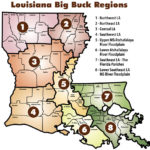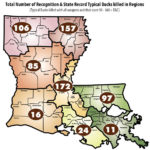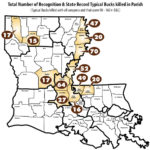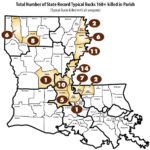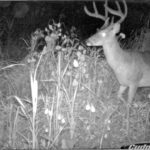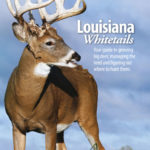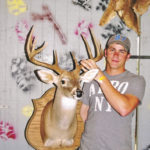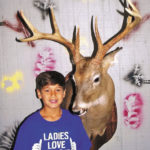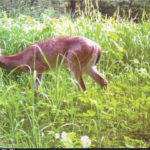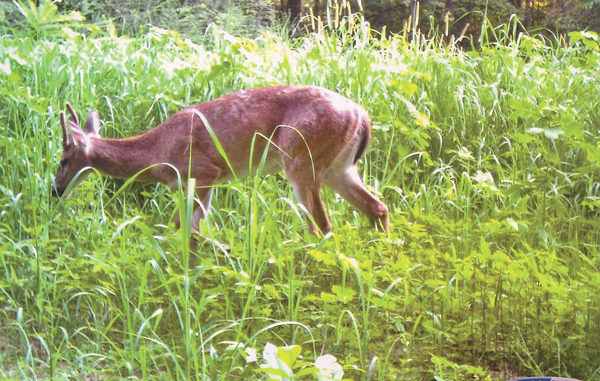
Previous buck trophies give Louisiana hunters hints for hotspots
What is a trophy buck?
This is pretty much a subject for debate at every hunting camp in the state. It is also a subject written about every year in the many hunting magazines across the country.
Certainly any buck harvested under fair chase is a trophy buck — a hunter’s first buck, a first buck with a bow, a first buck with a muzzleloader, a first buck taken while hunting over a scrape, and so on and so on. Beauty as well as trophy status is in the eye of the beholder.
There are, however, standards established by different entities that determine trophy-buck status.
The Boone & Crockett and Pope & Young clubs are two organizations that have established standards that define trophy status. Louisiana has adopted these standards into their Big Game Records Program, and any buck harvested with a gun that scores 130 on the B&C scale will qualify for recognition on the annual Big Buck Recognition List. Most hunters will mount a 130-class buck.
A typical buck taken with a gun scoring 160 or more qualifies for the State Record List and for B&C recognition. This is certainly a bona-fide trophy buck.
The minimum scores for the bow and muzzleloader typical categories are less than that of the gun hunter, obviously because of weapon type. A 110 B&C score for a bow-killed buck will qualify for the State Record List as will a 120 typical muzzleloader buck. A typical score of 125 qualifies a hunter for the P&Y Record Book, and a 130 typical muzzleloader buck puts one in the Longhunter Society Record Book.
If you are trying to connect with a trophy buck, obviously you don’t pull the trigger on every buck you see. Judging bucks in the field is not an easy task, especially when the buck gives you only a few seconds to make the decision. If your objective is to shoot a mature buck, you must consider body size along with the rack; however, if a trophy is what you’re after, the rack is the focal point of your decision.
A quick way to determine the score of the rack is to estimate the beam length, length of the points, the circumference of the antler at the base and the inside spread. To score well, a buck should have 20-inch main beams, so this would be the first consideration and would give you 40 points right off the bat; if the G1, G2 and G3 points are 5 inches, 10 inches and 10 inches, and are the same on both sides, you have an additional 50 points.
Check the inside spread, if the spread is greater than the ear tips when the ears are pointed outward, you have a 16-inch inside spread, and that puts you at 106.
Finally, look at the antler mass; if the bases appear heavy, at least 4 1/2 inches, then you should have an easy 15 points for the total circumference measurements (four on each side), another 30 points, which now gives you a rough score of 136 for an 8-pointer and, if deductions are few, a 130-class gun buck and at least a 125-class bow buck.
If the beams are short and the G2 and G3 points less than 10 inches, you probably do not need to pull the trigger if you are set on a true trophy.
With a little bit of study, you can become familiar with rack terminology. Look at a few mounted deer and estimate the beam lengths, lengths of the points, inside spread and basal circumference and then get your ruler out and check your estimate. I guess the key is to be able to do this in a matter of seconds in the field — not an easy task when a mature buck is in your grasp and you don’t have all day to decide. If your estimate puts him right on the borderline for what you are looking for, then don’t shoot; deductions will kill you. A true B&C buck will really stand out, and that makes the decision somewhat easy.
Where to hunt a trophy?
Most of the deer habitat in this state can produce a 130-class buck. However, on much of the deer habitat in the state, a 130-class buck is a top end buck, and there will not be many of them on the landscape.
All habitat types in this state will produce a buck that scores 90 B&C, which puts you on the Big Buck Recognition List if killed with a bow. So, if you’re not able to go to where the big ones live, you might consider challenging yourself with a different weapon — a bow rather than a gun. It is a little different when your ability to reach out and touch is restricted to 20 yards.
The Northeast Region of the state and the Upper Mississippi/Atchafalaya Floodplain Region have the highest number of recognition and record-book bucks. These two regions contain bottomland hardwood forests along with row crop farmland. Obviously these two regions would be the place to hunt for a trophy buck.
The pine/hardwood habitat of the Northwest Region, the Central Region and the Southeast Florida Parish Region are similar in the total harvest of recognition and state-record bucks, and so there is some opportunity for trophy hunters in these regions.
Southwest Louisiana, the Lower Atchafalaya Basin Floodplain and the Lower Southeast Mississippi River Floodplain are low on the totem pole for recognition and state-record bucks and would not be the place to go.
A region is a pretty large area, so we need to narrow down our hunt locations. Table 1 gives the data for the 12 parishes with the most recognition and state record bucks. It shows that Northeast Louisiana and the Upper Mississippi/Atchafalaya River Floodplain are definitely the best choices for trophy hunters. The number of recognition and state-record bucks is similar for the top-five parishes, and their numbers really begin to fall off with the next seven parishes.
West Feliciana has both river bottom and upland hardwood forest habitat, and has always produced trophy bucks. Despite the fact that the Northwest Louisiana Region parishes (Union, Bienville, Claiborne, Bossier, Webster) lead the state in total deer killed, this region has only two parishes on the list.
Rapides is the only parish in Central Louisiana harvesting some good state-record bucks along with the parishes of St. Landry, East Feliciana, Madison and Pointe Coupee in the other regions.
Table 2 presents the data for the top recognition and state-record bucks harvested during the 2010 season for some of the parishes in Table 1.
Many deer that are unofficially scored at big-buck contests across the state are never officially scored, so the data for Table 2 is somewhat limited. Just like we found in Table 1, the data from 2010 shows that the Upper Mississippi/Atchafalaya Region and the Northeast Region lead the way in the harvest of big bucks with West Feliciana from the Southeast Florida Parish Region being up there also.
One way to really pinpoint the best parish for a trophy buck is to look at the number of true B&C deer in Table 1. Notice that East Carroll Parish drops off the radar. The reason East Carroll is at the top of the list in Table 1 is due to the number of P&Y bucks that have been killed at Willow Point. This tract of commercial hunting land caters to the bow hunter and has more P&Y bucks than any other place in the state. But when one considers the 160-class trophy, this parish falls to the bottom.
Tensas, Avoyelles and Concordia parishes are in the fertile crescent of the state, and are at the top of the list for B&C trophies. Madison, St. Landry and West Feliciana are right up there also. Notice the connection — bottomland hardwood forests and row-crop agriculture, although West Feliciana is now lacking in that commodity.
East Feliciana falls off the radar also with its cattle pasture and pine-dominated forest habitat.
Pointe Coupee is also off the radar regarding true B&C-class bucks, primarily due to its history of high deer densities. Perhaps the 2011 flooding actually helped with this issue, but from what I have seen in the upper Morganza Floodway, there are still plenty of deer.
The two ringers that jump out are Bossier and Bienville parishes. There is an area where these two parishes connect together that historically has produced B&C-class bucks. The floodplain created by the Red River, Red Chute Bayou and Loggy Bayou is similar in fertility to that of the Mississippi/Atchafalaya fertile-crescent, and has bottomland hardwood timber and row-crop agriculture.
While Caddo Parish is not listed in Table 1 because it is on the list for typical deer, there have been four non-typical B&C bucks killed in this parish along with two typical B&C, so this is yet another indication that Northwest Louisiana will produce trophy bucks and is an area that hunters should look into.
During the 2010 season, Peyton Massey of Shreveport killed a 170-class typical buck that placed fifth in the Simmons Contest.
The good news for hunters is that there is plenty of public land available for hunting trophy-class deer. Loggy Bayou WMA, Red River WMA, Three Rivers WMA, Big Lake WMA, Buckhorn WMA, Thistlethwaite WMA, Tensas River NWR, Lake Ophelia NWR and Tunica Hills WMA are located in these regions and parishes, and offer excellent opportunity for bowhunting, primitive hunting and gun hunting.
When to hunt a trophy
This is a no-brainer. Hunt when the deer are most active — hunt the rut. The big bucks killed during the 2010 deer season once again provide proof that this is the time to hunt.
Anthony Plattsmeir killed a 163 6/8 typical B&C buck in St. Landry Parish on Jan. 11. Kenneth Bordelon killed a 209 3/8 B&C non-typical buck in Avoyelles Parish on Jan. 3. Both of these parishes are in the late-rut region of Area 6. January is the peak month for breeding, and January is the month to hunt, except now DMAP clubs will have some gun hunting opportunity in February. A hunter is foolish to burn up his hunting days in November and early December in this part of the state. Eight of the 13 big bucks killed in Avoyelles Parish in 2010 were killed in January.
Kevin Breaux hunting in St. Mary Parish on Jan. 14 killed his 176 5/8 typical B&C parish-record buck. Calvin Ardoin killed a 139 7/8 typical buck in Concordia Parish on Jan. 8. Steven Smith killed a 154 7/8 B&C typical buck in West Feliciana Parish, which is the new state crossbow record, on Dec. 27, and Richie Schaefer killed a 153 7/8 typical buck on Dec. 23 in St. Tammany Parish, which is a new record for that parish.
Some parishes in Area 1 have a December/January breeding schedule, and some are like Upper Area 6 with a January/February breeding schedule.
The bottom line as far as when to hunt is simply this — hunt the rut, the time when the deer are most active. Hunt the first month of breeding activity and save some days for the second month, when the heat is really on.
Heard about a big buck kill? Know some details? Let’s talk about it at www.LouisianaSportsman.com
